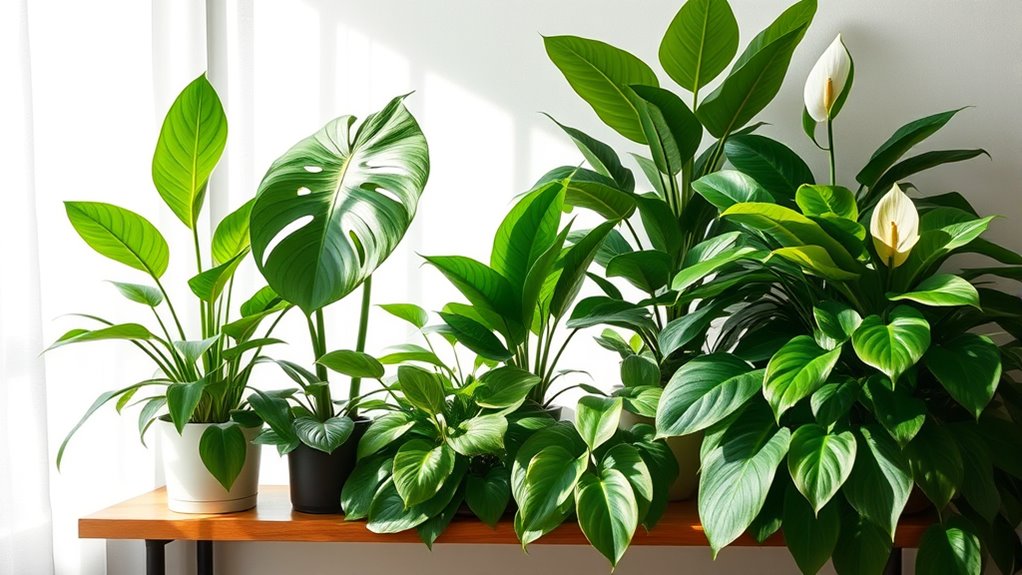To create a healthier home environment, consider adding houseplants that actively purify the air. Top options include the snake plant, pothos, and peace lily, known for their ability to filter common toxins like formaldehyde and benzene. These low-maintenance plants thrive indoors with proper care, such as adequate light and watering. If you want to discover more about how these plants can enhance your space, keep exploring the best options for your home.
Key Takeaways
- Snake plant, pothos, and peace lily are among the top air-purifying houseplants proven to remove indoor toxins.
- These plants are low-maintenance, making them ideal for busy households or beginners.
- Proper care, including adequate indirect light and correct watering, enhances their pollutant absorption.
- Regularly cleaning leaves boosts their ability to filter airborne chemicals effectively.
- Incorporating these plants improves indoor air quality and contributes to a healthier living environment.

Houseplants do more than add greenery to your home; they actively improve indoor air quality. If you’re looking to create a healthier living environment, choosing the right plants is essential. Many air purifying varieties have been scientifically proven to filter out common indoor pollutants like formaldehyde, benzene, and trichloroethylene. These plants not only beautify your space but also work tirelessly to remove toxins, making the air you breathe cleaner and safer. When selecting air purifying varieties, consider plants like the snake plant, pothos, and peace lily, which are renowned for their ability to absorb airborne chemicals. These plants are generally low-maintenance, but understanding proper care tips can ensure they thrive and continue to purify your air effectively.
Caring for these air purifying varieties isn’t complicated, but a few key tips can maximize their health and filtering capabilities. For instance, most of these plants prefer bright, indirect light, so placing them near a window with filtered sunlight is ideal. Overwatering is a common mistake, so always check the soil moisture before watering—many of these plants prefer to dry out slightly between waterings. Additionally, ensure proper drainage to prevent root rot, which can harm the plant’s ability to purify air. Regularly wiping leaves with a damp cloth helps remove dust that can block the plant’s pores, enhancing their ability to filter pollutants. Some plants, like the snake plant, are particularly forgiving if you forget to water them for a week or two, making them perfect for busy households or those new to plant care.
A further benefit is that many of these plants have been studied for their contrast ratio in relation to their overall effectiveness in improving indoor air quality, which underscores their value beyond simple decoration. Proper lighting, watering, and maintenance will ensure these plants remain healthy and continue to serve as natural air filters. With consistent care, your air purifying varieties will not only beautify your space but also improve the quality of your indoor air, supporting a healthier, more vibrant home environment.
Frequently Asked Questions
How Often Should I Water Air-Purifying Houseplants?
You should water your air-purifying houseplants when their top inch of soil feels dry, usually every 1-2 weeks. Adjust watering frequency based on your plant’s hydration needs and environmental factors like humidity and light. Overwatering can cause root rot, so it’s better to check soil moisture regularly. Consistent, proper watering helps your plants stay healthy and effectively purify the air around you.
Do All Houseplants Effectively Remove Indoor Toxins?
Not all houseplants effectively remove indoor toxins, as plant efficacy variability exists. Some plants excel at plant toxin removal, while others have limited air-purifying abilities. You should choose plants known for their air-cleaning properties, like snake plants or pothos, to improve your home’s air quality. Remember, combining multiple plants enhances overall air purification, but no single plant can completely eliminate all indoor toxins.
Which Plants Are Safest for Homes With Pets or Children?
When choosing plants for homes with pets or children, you want pet-safe plants and child-friendly greenery that won’t harm your loved ones. Look for options like spider plants, Boston ferns, or areca palms, which are non-toxic and safe around kids and animals. Always double-check plant labels and keep potentially harmful plants out of reach. Choosing safe, non-toxic houseplants helps create a healthy, worry-free environment for everyone.
Can Houseplants Improve Sleep Quality and Reduce Allergies?
Ever wondered if houseplants can help you sleep better? They can! Certain allergy reduction plants, like lavender and snake plants, release compounds that promote relaxation and improve air quality. These plant sleep benefits include reducing allergens and increasing humidity, which eases breathing. Incorporating these plants into your home creates a calming environment, making it easier to fall asleep and stay asleep, all while helping to reduce allergy symptoms naturally.
How Much Sunlight Do Air-Purifying Plants Typically Need?
Air-purifying plants usually need moderate to bright sunlight to thrive, but their sunlight requirements vary. Some, like snake plants, have high shade tolerance and can grow well in low light, while others, like pothos, prefer indirect sunlight. To keep your plants healthy and effective at purifying air, place them where they get the right amount of sunlight suited to their needs, and adjust based on their shade tolerance.
Conclusion
Imagine transforming your space into a healthier haven with just a few houseplants. For example, Sarah added a snake plant to her living room, and within weeks, she noticed fresher air and fewer allergies. By choosing top air-purifying plants like these, you can effortlessly boost your home’s air quality. Start small—your lungs will thank you, and your home will feel more vibrant and inviting every day.









